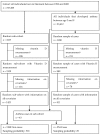Neonatal Vitamin D Status and Risk of Asthma in Childhood: Results from the D-Tect Study
- PMID: 32245170
- PMCID: PMC7146263
- DOI: 10.3390/nu12030842
Neonatal Vitamin D Status and Risk of Asthma in Childhood: Results from the D-Tect Study
Abstract
Background: low vitamin D status in pregnancy can influence the offspring's lung function and contribute to childhood asthma development. The objective of this study was to examine the influence of neonatal vitamin D status on the development of asthma among children age 3-9 years in a large population sample.
Method: in a case-cohort study utilizing a Danish biobank and register data we examined the association between neonatal 25-hydroxyvitamin D3 (25(OH)D3) concentrations and incidence of asthma among children aged 3-9 years. Cases of asthma (n = 911) were randomly selected among all cases of asthma in the Danish National Patient Register from children born between 1992 and 2002. The sub-cohort (n = 1423) was randomly selected among all children born in the same period. We used a weighted Cox proportional hazard model assessing the hazard of first asthma diagnoses by quintiles of 25(OH)D3.
Results: the median 25(OH)D3 (interquartile range) for asthma cases was 23 nmol/L (14-35) and the sub-cohort 25 nmol/L (14-40). The hazard ratio for developing asthma between ages 3 and 9 years was lower for children in the fifth quintile of neonatal 25(OH)D3 compared to children in the first quintile, both in the unadjusted (0.61 95% CI: 0.46-0.80) and adjusted (0.55 95% CI: 0.39-0.77) analyses.
Conclusion: the results from our study suggest that higher neonatal vitamin D concentration may reduce the risk of developing childhood asthma at ages 3-9 years, indicating that neonatal vitamin D status as a proxy of vitamin D status during the prenatal period is important for normal immune- and lung development.
Keywords: asthma; childhood; neonatal; vitamin D.
Conflict of interest statement
The authors declare no conflict of interest.
Figures


Similar articles
-
Neonatal vitamin D status from archived dried blood spots and future risk of fractures in childhood: results from the D-tect study, a population-based case-cohort study.Am J Clin Nutr. 2017 Jul;106(1):155-161. doi: 10.3945/ajcn.116.145599. Epub 2017 May 17. Am J Clin Nutr. 2017. PMID: 28515065
-
Vitamin D concentrations from neonatal dried blood spots and the risk of early-onset type 2 diabetes in the Danish D-tect case-cohort study.Diabetologia. 2021 Jul;64(7):1572-1582. doi: 10.1007/s00125-021-05450-2. Epub 2021 May 24. Diabetologia. 2021. PMID: 34028586
-
Neonatal vitamin D status and risk of childhood epilepsy.Epilepsia. 2020 Jun;61(6):1282-1290. doi: 10.1111/epi.16520. Epub 2020 May 4. Epilepsia. 2020. PMID: 32363640
-
Maternal vitamin D status during pregnancy and risk of childhood asthma: A meta-analysis of prospective studies.Mol Nutr Food Res. 2017 May;61(5). doi: 10.1002/mnfr.201600657. Epub 2017 Mar 21. Mol Nutr Food Res. 2017. PMID: 27981740 Review.
-
Maternal Vitamin D Status and Development of Asthma and Allergy in Early Childhood.Mini Rev Med Chem. 2015;15(11):900-12. doi: 10.2174/1389557515666150519105741. Mini Rev Med Chem. 2015. PMID: 25985950 Review.
Cited by
-
The Role of Vitamin D in Respiratory Allergies Prevention. Why the Effect Is so Difficult to Disentangle?Nutrients. 2020 Jun 17;12(6):1801. doi: 10.3390/nu12061801. Nutrients. 2020. PMID: 32560403 Free PMC article. Review.
-
Environmental Factors and the Risk of Developing Type 1 Diabetes-Old Disease and New Data.Biology (Basel). 2022 Apr 16;11(4):608. doi: 10.3390/biology11040608. Biology (Basel). 2022. PMID: 35453807 Free PMC article. Review.
-
Low Vitamin D Levels at Birth and Early Respiratory Outcome in Infants With Gestational Age Less Than 29 Weeks.Front Pediatr. 2022 Jan 21;9:790839. doi: 10.3389/fped.2021.790839. eCollection 2021. Front Pediatr. 2022. PMID: 35127591 Free PMC article.
-
Effects of High-Dose Vitamin D Supplementation on Placental Vitamin D Metabolism and Neonatal Vitamin D Status.Nutrients. 2024 Jul 5;16(13):2145. doi: 10.3390/nu16132145. Nutrients. 2024. PMID: 38999892 Free PMC article. Clinical Trial.
-
Maternal dietary folate intake with folic acid supplements and wheeze and eczema in children aged 2 years in the Japan Environment and Children's Study.PLoS One. 2022 Aug 22;17(8):e0272968. doi: 10.1371/journal.pone.0272968. eCollection 2022. PLoS One. 2022. PMID: 35994490 Free PMC article. Clinical Trial.

